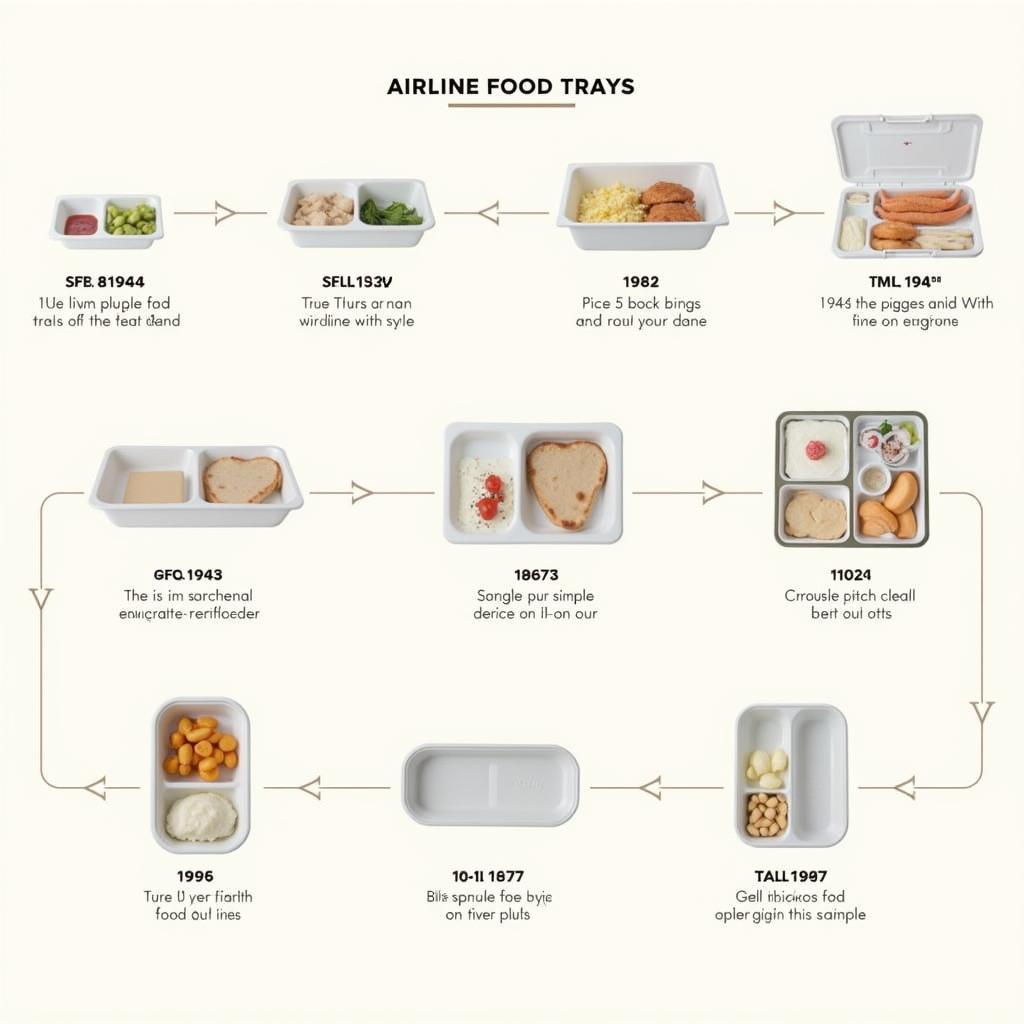The humble Airline Food Tray: a familiar sight to frequent flyers and a source of endless curiosity for those less acquainted with the skies. But have you ever stopped to think about the history, logistics, and future of this airborne dining staple? Let’s delve into the fascinating world of the airline food tray, exploring its evolution, the challenges it presents, and how airlines are striving to create a more enjoyable and sustainable in-flight dining experience.
A Brief History of Dining at 30,000 Feet
 Evolution of Airline Food Trays
Evolution of Airline Food Trays
The first in-flight meal was served in 1919 on a Handley Page Transport flight from London to Paris. Passengers were treated to pre-packed lunch boxes, a far cry from the multi-course meals offered by some airlines today. The introduction of the airline food tray as we know it came in the 1930s, marking a shift towards a more organized and efficient way to serve food at altitude.
The Anatomy of an Airline Food Tray
An airline food tray is more than just a plate in the sky. It’s a carefully engineered system designed to maximize space and minimize waste while adhering to strict safety regulations.
- Compartments: Multiple compartments accommodate a variety of dishes, from appetizers and salads to main courses and desserts.
- Materials: While early trays were often made of metal, today’s versions prioritize lightweight and recyclable materials like plastic and aluminum.
- Design: Trays are designed to be stackable and compact for efficient storage and transportation in the limited galley space.
The Challenges of In-Flight Catering
Preparing and serving food on an airplane comes with its own set of unique challenges:
- Space constraints: Aircraft galleys are notoriously small, requiring careful planning and efficient use of space.
- Altitude’s effects on taste: The low air pressure and humidity at high altitudes can affect our sense of taste, making food seem bland.
- Food safety: Maintaining food safety is paramount, with rigorous temperature control and hygiene protocols in place.
Elevating the In-Flight Dining Experience
Airlines are continuously exploring ways to improve the in-flight dining experience:
- Collaborations with renowned chefs: Some airlines are partnering with celebrity chefs to create restaurant-quality meals for their passengers.
- Focus on fresh, locally sourced ingredients: There’s a growing trend towards using fresh, seasonal ingredients sourced from local farms and producers.
- Sustainable practices: Airlines are increasingly adopting eco-friendly practices, such as using biodegradable packaging and reducing food waste.
The Future of Airline Food
The future of the airline food tray looks promising, with airlines exploring innovative ways to make in-flight dining more enjoyable and sustainable:
- Personalization: Imagine ordering meals tailored to your dietary preferences and needs, all pre-selected before you even step foot on the plane.
- Technology integration: From interactive menus to pre-ordering options, technology is set to revolutionize the in-flight dining experience.
- Sustainability at the forefront: Expect to see even greater emphasis on eco-friendly practices, such as compostable packaging and zero-waste initiatives.
Conclusion
The airline food tray, often the subject of lighthearted jokes, is a testament to the complexities of in-flight catering. As airlines continue to innovate, we can anticipate a future where dining at 30,000 feet is not just a necessity but a delightful part of the journey.
Frequently Asked Questions About Airline Food Trays
1. Why is airline food often perceived as bland?
The low air pressure and humidity at high altitudes can affect our sense of taste, making food seem less flavorful than it would on the ground.
2. Are airline food trays recyclable?
Many airlines are transitioning to more sustainable practices, including the use of recyclable or compostable materials for their food trays. However, it’s best to check with the specific airline for their recycling policies.
3. Can I bring my own food on an airplane?
Generally, yes, you can bring your own food on a plane, but there might be restrictions on liquids and certain types of food. It’s always advisable to check with the airline before your flight.
4. What are airlines doing to reduce food waste?
Airlines are implementing various strategies to minimize food waste, including optimizing meal planning based on passenger data, donating unused food to charities, and composting food scraps.
5. Can I request a special meal for dietary restrictions?
Yes, most airlines offer a wide range of special meals to cater to various dietary needs, such as vegetarian, vegan, gluten-free, and kosher options. These meals need to be requested in advance, usually during the flight booking process.
Need help with airplane themed food? We can help you! We are a team of food lovers who are always happy to help. Please contact us via Phone Number: 02437655121, Email: minacones@gmail.com Or visit us at: 3PGH+8R9, ĐT70A, thôn Trung, Bắc Từ Liêm, Hà Nội, Việt Nam. We are available 24/7.